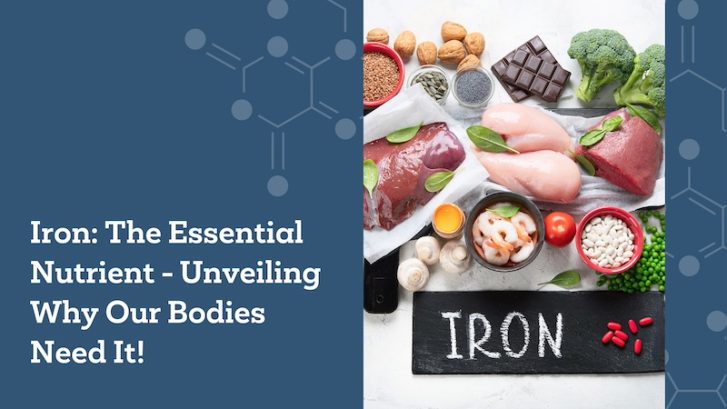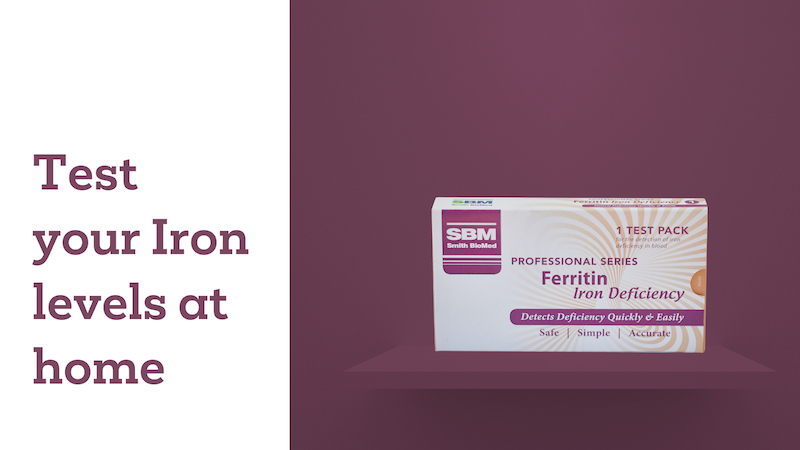We’re here to talk about that superhero again. You know the one, the one that delivers oxygen to every cell in the body giving us the energy needed to function properly.
Iron.
In the realm of nutrition, few elements hold as much significance as iron. Despite its relatively modest presence in the body, iron plays a pivotal role in numerous physiological processes, making it an indispensable nutrient for human health. From oxygen transport to cellular metabolism, the functions of iron are diverse and essential. In this exploration, we delve into the intricate mechanisms behind iron’s importance, shedding light on why our bodies need it. We’re also going to cover some symptoms of low iron, things to look out for if you think you have an iron deficiency, and some iron-rich foods to help.
Understanding Iron
Iron stands as one of the most abundant elements on Earth, and its presence in the human body is equally profound. It serves as a critical component of haemoglobin which is the protein responsible for carrying oxygen from the lungs to various tissues and organs. Additionally, iron is a key constituent of myoglobin, a protein found in muscle cells that facilitates oxygen storage and release during muscle contraction. These functions highlight the importance of iron in upholding cellular respiration and energy generation, fundamental processes crucial for sustaining life.
As you consume iron-rich foods, the mineral travels through your digestive system, where it is absorbed by your body. Subsequently, iron contributes to the formation of haemoglobin within your red blood cells. Haemoglobin, a vital protein, facilitates the transportation of oxygen throughout your body. With each breath we take, haemoglobin gathers oxygen from your lungs and distributes it to various tissues and organs, ensuring their proper oxygenation. Insufficient oxygen supply to your organs can result in fatigue, weakness, and breathlessness.
We know Iron is essential for the body to function properly but it is also widely known for its benefits when it comes to strengthening the immune support, sleep quality, foetal health, and preventing anaemia.
Blood can be tested to see how much iron you have. It is tested through how much ferritin (the blood protein that binds to iron) is present and gives you a good indication of your iron stores.
Oxygen Transport
The primary function of iron in the body revolves around oxygen transport. Within the bloodstream, haemoglobin binds to oxygen molecules in the lungs, forming oxyhemoglobin, which is then transported to tissues throughout the body. In the absence of adequate iron levels, the synthesis of haemoglobin is impaired, leading to decreased oxygen-carrying capacity and potential complications such as anaemia.
Anaemia
Iron deficiency anaemia is what we can get if we have extremely low iron levels. It is a condition characterised by a deficiency of red blood cells or haemoglobin in the blood, resulting in reduced oxygen-carrying capacity. Common symptoms of anaemia can vary depending on its severity and underlying cause but may include:
- Fatigue: Persistent tiredness or lack of energy, even after adequate rest, is a hallmark symptom of anaemia. It results from the body’s decreased ability to transport oxygen to tissues and organs.
- Weakness: Anaemic individuals may experience generalised weakness or a sense of physical exhaustion, making it challenging to perform routine activities.
Shortness of Breath: Reduced oxygen delivery to tissues can lead to shortness of breath, especially during physical exertion or activity. Individuals with anaemia may feel breathless even with minimal exertion. - Pale Skin: Anaemia can cause a pale complexion due to decreased red blood cell production or haemoglobin levels. This pallor may be particularly noticeable in the face, lips, and inner lining of the lower eyelids.
Dizziness or Lightheadedness: Reduced oxygen supply to the brain can result in feelings of dizziness, lightheadedness, or faintness, especially when standing up quickly or exerting oneself. - Headaches: Anaemic individuals may experience frequent headaches or migraines, which can be exacerbated by reduced oxygen delivery to the brain.
Cold Hands and Feet: Decreased circulation and oxygenation of tissues may cause extremities, such as hands and feet, to feel unusually cold to the touch.
Irregular Heartbeat (Palpitations): Anaemia can lead to a rapid or irregular heartbeat (palpitations) as the heart works harder to compensate for decreased oxygen-carrying capacity. - Chest Pain: In severe cases of anaemia, individuals may experience chest pain or angina due to the heart’s increased demand for oxygen and decreased supply.
Brittle Nails and Hair Loss: Chronic iron-deficiency anaemia can manifest in brittle nails, hair loss, and other changes in hair and nail texture and quality. - Restless Legs Syndrome (RLS): An association between iron deficiency anaemia and restless legs syndrome (RLS) has been observed, characterised by uncomfortable sensations in the legs and an irresistible urge to move them, particularly at rest or during sleep.
It’s important to note that symptoms of anaemia can vary widely among individuals and may be influenced by factors such as age, overall health, and the underlying cause of the anaemia. If you suspect you may have symptoms of anaemia, it’s essential to consult a healthcare professional for proper evaluation, diagnosis, and treatment.
Cellular Metabolism
Beyond its role in oxygen transport, iron participates in various enzymatic reactions essential for cellular metabolism. Iron-containing enzymes, such as cytochromes and catalases, play crucial roles in energy production, DNA synthesis, and antioxidant defence mechanisms. These enzymes catalyse reactions involved in the conversion of nutrients into usable energy and the detoxification of harmful free radicals, highlighting iron’s multifaceted contributions to cellular health.
Immune Function
Iron also plays a pivotal role in immune function, as it is required for the proliferation and differentiation of immune cells. Macrophages, a type of immune cell, rely on iron for phagocytosis—the process by which they engulf and neutralise pathogens. Furthermore, iron deficiency can compromise immune responses, making individuals more susceptible to infections and impairing the body’s ability to combat pathogens effectively.
Development and Growth
Iron is particularly crucial during periods of rapid growth and development, such as infancy, childhood, and adolescence. Adequate iron intake is essential for optimal cognitive development, as iron deficiency during these critical stages can impair learning, memory, and overall cognitive function. Moreover, iron deficiency anaemia in pregnant women poses risks to both maternal and foetal health, underscoring the importance of sufficient iron intake during pregnancy to support healthy growth and development. And this leads us on to how to get more iron in your diet.

Dietary Sources
While iron is abundantly available in various foods, its absorption rates can vary depending on the source. Heme iron, found in animal products such as red meat, poultry, and fish, is more readily absorbed by the body compared to non-heme iron, which is present in plant-based sources like legumes, fortified cereals, and leafy greens. Something that’s not always considered is consuming vitamin C-rich foods alongside iron-rich meals can enhance iron absorption. While certain substances such as phytates (a citric acid found in seeds, black tea, coffee and wine) and tannins (an antioxidant) may inhibit absorption and should be consumed in moderation.
If you’re looking to increase the amount of iron in your diet, here are some iron-rich foods:
- Lean red meat
- Fish
- Poultry
- Lentils and beans
- Dried fruits (prunes, figs and apricots)
Sometimes when your iron is extremely low, eating iron-rich food may not be enough to increase your levels. When this is the case, an iron supplement could be prescribed when consulting a medical professional.
Wound Healing
Iron is involved in the synthesis of collagen, a protein that the body makes to support wound healing and tissue repair. Collagen is a fibre-like protein that helps make connective tissue stronger that can withhold stretching. Adequate iron levels promote faster healing by transporting oxygen to the wound site for various cellular processes involved in wound healing, including cell proliferation, collagen synthesis, and tissue remodelling.
If a wound or injury is taking a substantial amount of time to see any improvement, an iron test could help rule out any sort of iron deficiency.

Conclusion
In conclusion, iron stands as an indispensable nutrient essential for numerous physiological functions within the human body. From oxygen transport to cellular metabolism and immune function, iron plays a central role in sustaining life and promoting overall health and well-being. Recognising the importance of maintaining adequate iron levels through a balanced diet and, when necessary, supplementation is paramount in preventing iron deficiency and its associated complications. By unveiling the intricacies of iron’s significance, we gain a deeper appreciation for this essential nutrient and its profound impact on human health.
Now that you know how iron works in our bodies and what to look for when there is a potential iron deficiency you may want to consider testing your own iron levels. Smith Biomed have created an at-home Ferritin Iron Deficiency Test that is available at pharmacies.
If there is an iron deficiency, it is important to understand it comes from a diet perspective, or an underlying health condition. When completing your own test and low iron is detected it is vital to seek medical attention to confirm your iron levels and get treatment necessary.


